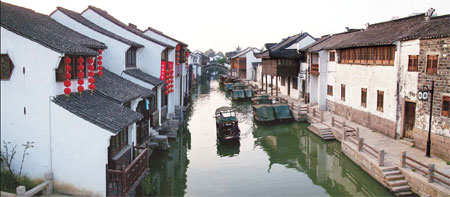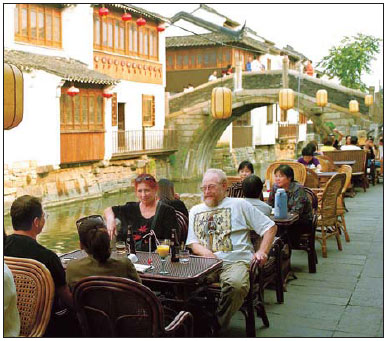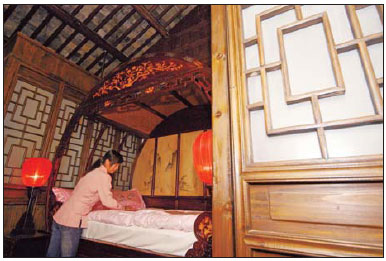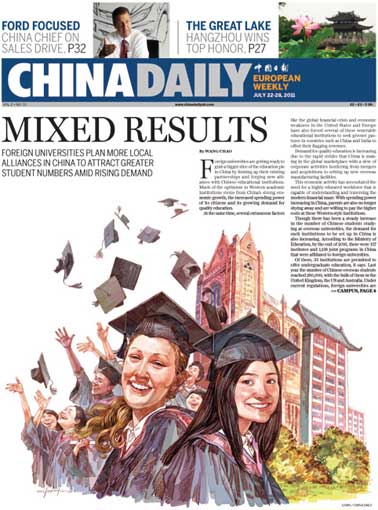Tips and Articles
Bastion of bohemians
Updated: 2011-07-14 07:58
By Erik Nilsson (China Daily)
|
A boat cruise along Suzhou's ancient canal, which is flanked by traditional two-story houses, is like a journey back in time. Provided to China Daily |
|
Teahouses and cafes enjoy booming business in Shantang. Provided to China Daily |
|
A 100-year-old compound is redeveloped into a hotel on Pingjiang Street. Xu Zhiqiang / for China Daily |

Tourism takes advantage of the canals in Suzhou's Pingjiang Historic Quarters, a rich cultural and economic legacy. Erik Nilsson reports.
The Terracotta Warrior brandishing an electric guitar near the gate of Suzhou's Ping-jiang Historic Quarters embodies the intersection of antiquity and modernity that defines it. Both the body and spirit of the ancient canal street in East China's Jiangsu province have survived more than 2,500 years of war and natural disasters. Its architecture has remained essentially intact, and it has never lost its soul as a bastion of bohemians - hip artist types, renegade literati and poets.
Members of today's alternative set inhale on hookahs while sprawled across kang (traditional beds) in cafes, work behind easels atop canal bridges and thumb through philosophy books in teahouses.
They occupy such establishments as Momi Cafe, the counter of which has been constructed from stacked books, and the Suzhou Architec-tural Garden, that showcases mo-dern innovations on traditional minzhai (local houses).
The umbilical link of Pingjiang's past and present is the canal, a shimmering water ribbon that's said to be the most picturesque in the city that's celebrated as the "Venice of the Orient".
The stunning views the waterway creates have sustained the street's eminence as a source of poetry and stomping ground of the prose masters who pen its homage.
The way the waterway mirrors scenes of the street it intersects projects an aquatic doppelganger of Pingjiang on its surface.
Flowering vines cascade from the canal's edge into their mirror images in the ripples, and the arches of the ancient footbridges that jump across the channel are rendered as circles when reflected below.
Wupengchuan, the traditional "black-roofed boats", barely scrape beneath the bellies of these bridges, as they have since ancient days.
It's a similar story on Shantang Street, an alike ancient canal street in Suzhou, where boats bob on waters that have inspired poets for centuries.
The 3.5-km-long street has remained essentially unchanged since Tang Dynasty (AD 618-907) poet and local official Bai Juyi ordered its construction.
Bai's prose describes his handiwork as a "typical Suzhou street" that follows the formula of "one street, one river, small bridges, floating water and white walls".
Because Shantang is so narrow, its walls are pocked with windows to create the illusion of wider spaces, colloquially described as "one step, one scene".
The street is flanked by houses built according to traditional nongtang architecture, characterized by two-story compounds containing about 30 homes.
Houses near the river have steps leading to the water. In ancient times, though, residents used their second-story windows to buy goods from floating markets.
Rather than walk down to deal with the vendors, whose boats were piled with produce, they would lower baskets full of money and hoist up vegetables.
Another unique feature of Shantang's streets are the removable doors.
Numbered wooden planks are pulled off a large opening on the first floors during the daytime and replaced at night. The doors are set atop carved rock swivels called shigu, or "stone drums", to protect the doors from rotting, as flooding is common.
About half of the buildings along Shantang Street are residential.
There are also handicraft stores, proffering such local products as pearls. The street also hosts chockablock teahouses that stage pingtan - performances in which pipa (lute) players strum ballads while crooning in the local dialect - and venues for the local Kunqu Opera, said to be the grandparent of the country's local operas.
Shantang is also lined with ancient chambers of commerce, such as the Guangzhou Assembly Hall, constructed in 1678 - artifacts that bear testimony to how the waterway has propelled the street's bustle as a commercial hub in ancient times.
Albeit today by tourism rather than cargo transport, Pingjiang and Shantang show how the canals of Suzhou's ancient streets continue to outpour a rich cultural and economic legacy.
E-paper
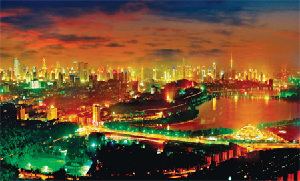
Ringing success
Domestic firms make hay as shopping spree by middle class consumers keeps cash registers ringing in Nanjing
Mixed Results
Crowning achievement
Living happily ever after
Specials

Ciao, Yao
Yao Ming announced his retirement from basketball, staging an emotional end to a glorious career.

Going the distance
British fitness coach comes to terms with tragedy through life changes

Turning up the heat
Traditional Chinese medicine using moxa, or mugwort herb, is once again becoming fashionable
